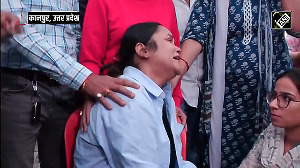
If you're planning to buy a fancy PDA-phone or a 'smartphone' in the near future, check whether it's 3G compatible. If it isn't, it will either be obsolete by the end of the year, or certainly won't be as much fun to use.
For, five years after they first made an entrance and enticed a host of European telecom companies to bid over ¤100 billion in license fees, and then go bust, the next generation of mobile technology (3G) is finally here.
-
Special: How to buy a mobile phone
For those who want to access the Net -- and that's really why you want a PDA-phone -- the 3G offers data speeds of well over 2 Mbps, which is over 10-20 times faster than what's available today on mobile phones that have GPRS facilities, or even on land lines that have what passes for broadband in most homes in the country today.
While there are already 20 million customers who have migrated to 3G mobiles (this was around six million last June), from the 2G GSM-platform globally, the state-owned Mahanagar Telecom Nigam Ltd has already floated a tender to four million lines of 3G equipment in India.
Market leader Airtel is currently surveying the market to see what capacity it wants to roll out with initially. By the end of next year, there could well be three operators offering 3G services in the country.
Since 3G is seen as a pricey technology in what is essentially a price-sensitive market, how well it will do on introduction will depend upon what kind of tariff plans are offered to customers, including the cost of the handsets.
While no local player has firmed up business plans as yet, no price plans can be indicated. But the European experience offers some valuable pointers on both costs of instruments as well as tariff plans.
3G-compatible handsets that cost around $700 last year are already down to around $300, and are expected to drop below $200 by the end of the year. By 2008, industry is looking at this halving.
The per line costs of a 3G network, similarly, have fallen dramatically, and are around 30 to 40 per cent higher than that for a conventional 2G network today.
But the advantage is that for the same amount of spectrum (the airwaves over which telecom signals are carried), a 3G network can carry over four to five times more voice traffic than a 2G network can, apart from giving high speed data access -- the effective costs, therefore, come down to levels that are not too much higher than existing 2G networks.
In Europe, 3G service companies have been dropping voice tariffs dramatically, though in return for a certain minimum bill size per month. Packages offered to customers committing to use 1,000 minutes a month in Europe are charging voice tariffs that are around half those available today on conventional 2G networks.
As a result, European telecom firms are looking at getting an average revenue per user, or ARPU, which is between 25 and 40 per cent higher than of a 2G bill.
Will price-sensitive Indian consumers shift in large enough numbers to a 3G system? While there's no doubt the market is low-value with each customer yielding just Rs 400 a month to the mobile phone companies (after deducting the licensing revenue share), around 5 to 10 per cent of customers pay monthly bills of more than Rs 1,000 per month.
Since most European 3G telecom firms are comfortable with customers who pay 25 to 40 per cent more than the average, this means potential 3G networks in India can bank upon a market of at least two to three million to begin with, and a lot more if they offer voice calls at a price lower than that offered by existing 2G networks.
Industry experts, however, are of the view that around 10 per cent of the existing 50 million mobile subscribers will move to 3G once it is introduced.
Over the past one year, according to data just released by IDC, non-voice revenue (basically SMS and surfing) for mobile phones grew by 139 per cent over the year.
This constitutes 5 per cent of current ARPUs and is expected to jump to 10 per cent within the next 12 months.
Another potential market that is growing by leaps and bounds today, and which could readily switch to 3G, is the current broadband Internet one, since speeds offered are many multiples of what is currently being offered.
And since the government has not allowed private providers to use MTNL/ BSNL's existing copper lines to access customers, broadband Internet simply has to ride on a 3G backbone.
Airtel, which has an existing broadband customer base of around 100,000, says the growth is around 10,000 per month.
The only hitch right now could be a regulatory one with both GSM and CDMA (Reliance Infocomm, primarily) operators locked in a battle over allocation of the 3G spectrum.
While GSM operators argue that the 1920-1980 and 2110-2170 Mhz spectrum frequency is the global standard for 3G operations (whether by GSM or CDMA players), the CDMA operators want this frequency for their current non-3G operations.
While the telecom regulator appears in favour of granting the CDMA operators what they want, the telecom ministry has not yet made up its mind on the matter.
This decision will determine whether Indians get to use 3G or not by the end of the year.
3G phone: The Motorola V1150 UMTS compatible mobile phone with a 2MP digital camera and a VGA video camera built in at the CeBIT technology trade fair on March 10 in Hanover, Germany.
Photo: Sean Gallup/Getty Images








 © 2025
© 2025